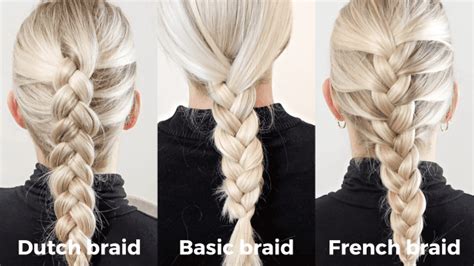Introduction
Braids are versatile hairstyles that have adorned heads for centuries. Two of the most popular braiding techniques are the Dutch braid and the French braid. Both create intricate and elegant looks, but each has its unique characteristics and advantages. This comprehensive guide will explore the key differences between these two braiding techniques, helping you choose the perfect style for your next special occasion or everyday look.

Defining Characteristics
Dutch Braid:
- Also known as an inside-out braid
- Strands are crossed over each other from the bottom instead of the top
- Creates a raised, textured effect
French Braid:
- Also known as an outside-in braid
- Strands are crossed over each other from the top
- Creates a flatter, more intricate look
Key Differences
| Feature | Dutch Braid | French Braid |
|---|---|---|
| Crossing Pattern | From bottom | From top |
| Effect | Raised, textured | Flatter, intricate |
| Difficulty | Moderate | Advanced |
| Appearance | More casual | More formal |
| Suitability | All hair types | Fine or thin hair |
Choosing the Right Braid for You
Dutch Braid
- Ideal for creating a bold, stand-out look
- Suitable for both casual and formal occasions
- Works well with thick or coarse hair
- Relatively easy to learn
French Braid
- Perfect for a sophisticated, elegant style
- Best for special occasions or events
- Adds volume to fine or thin hair
- Requires more practice to master
Step-by-Step Instructions
Dutch Braid:
- Divide hair into three equal sections.
- Cross the right strand over the middle strand.
- Bring the left strand under the new middle strand.
- Repeat steps 2-3, adding new hair from the sides as you braid.
- Continue braiding until you reach the end of the hair.
French Braid:
- Divide hair into three equal sections.
- Cross the right strand over the middle strand.
- Pick up a small section of hair from the right side and add it to the right strand.
- Cross the right strand over the middle strand.
- Repeat steps 3-4 on the left side, alternating sides.
- Continue braiding until you reach the end of the hair.
Pain Points and Motivations
Pain Points:
- Difficulty in mastering the braiding technique
- Tangled or frizzy hair
- Lack of confidence in styling abilities
Motivations:
- Desire to create a beautiful, unique hairstyle
- Want to add texture or volume to hair
- Improve braiding skills
Effective Strategies
Tips and Tricks:
- Practice regularly to improve technique
- Use a detangling brush or comb before braiding
- Add hairspray or mousse for hold
- Experiment with different braid sizes and patterns
- Divide hair into smaller sections for a tighter braid
Innovative Ideas:
- Create a half-up Dutch braid for a playful look
- Combine Dutch and French braids for a hybrid style
- Add beads or ribbons to braids for a decorative touch
- Try a fishtail braid variation for a unique twist
Conclusion
Whether you prefer the bold texture of a Dutch braid or the intricate elegance of a French braid, both techniques offer versatile and beautiful hairstyles that can transform your look. By understanding the key differences between these two braiding methods, you can choose the technique that best suits your hair type and desired style. With a little practice and creativity, you can master the art of braiding and create stunning hairstyles for any occasion.
